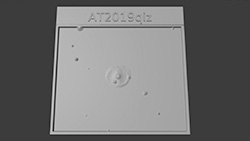CXC Home | Search | Help | Image Use Policy | Latest Images | Privacy | Accessibility | Glossary | Q&A
1
Illustration of AT2019qizCredit: NASA/CXC/SAO and Soheb Mandhai/The Astro Phoenix
Chandra and other telescopes have identified a supermassive black hole that has torn apart one star and is now using that stellar wreckage to pummel another star or smaller black hole. This artist’s illustration shows a disk of material (red, orange, and yellow) created after a supermassive black hole (depicted on the right) destroyed a star through intense tidal forces. After a few years, this disk expanded outward until it began intersecting another orbiting object — either a star or a small black hole — around the giant black hole. Each time this object crashes into the disk, it sends out a burst of X-rays detected by Chandra.
2
X-ray & Optical Images of AT2019qizCredit: X-ray: NASA/CXC/Queen's Univ. Belfast/M. Nicholl et al.; Optical/IR: PanSTARRS, NSF/Legacy Survey/SDSS; Image Processing: NASA/CXC/SAO/N. Wolk
These images show Chandra X-ray data, and optical images from Pan-STARRS of the area around AT2019qiz. Chandra and other telescopes have identified this supermassive black hole that has torn apart one star and is now using that stellar wreckage to pummel another star or smaller black hole.
The X-ray source at lower left is unrelated to the AT2019qiz system. It's most likely a supermassive black hole in a background galaxy located behind AT2019qiz.
The X-ray source at lower left is unrelated to the AT2019qiz system. It's most likely a supermassive black hole in a background galaxy located behind AT2019qiz.
3
3D Printable Files: AT2019qiz(3D Print Credit: NASA/CXC/A. Jubett, using software by Tactile Universe/N. Bonne & C. Krawczyk & Blender)
This tactile plate is a physical relief map based on the intensity of Chandra X-ray and Pan-STARRS optical data, depicting a supermassive black hole and its host galaxy. The plate depicts a wide field of space with a galaxy at the center. The galaxy contains two distinct raised dots, with the innermost dot showcasing a powerful black hole. Along with a second dot and the surrounding material of the galaxy, the whole object resembles a double-yolked egg frying in a pan.
Return to: Black Hole Destroys Star, Goes After Another, NASA Missions Find (October 9, 2024)

















